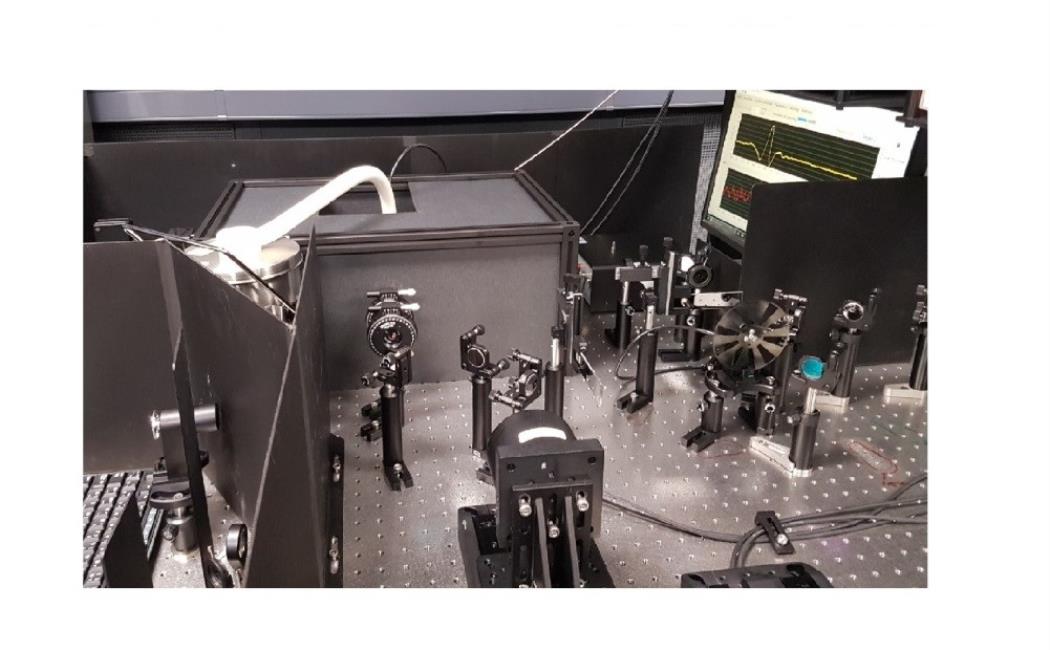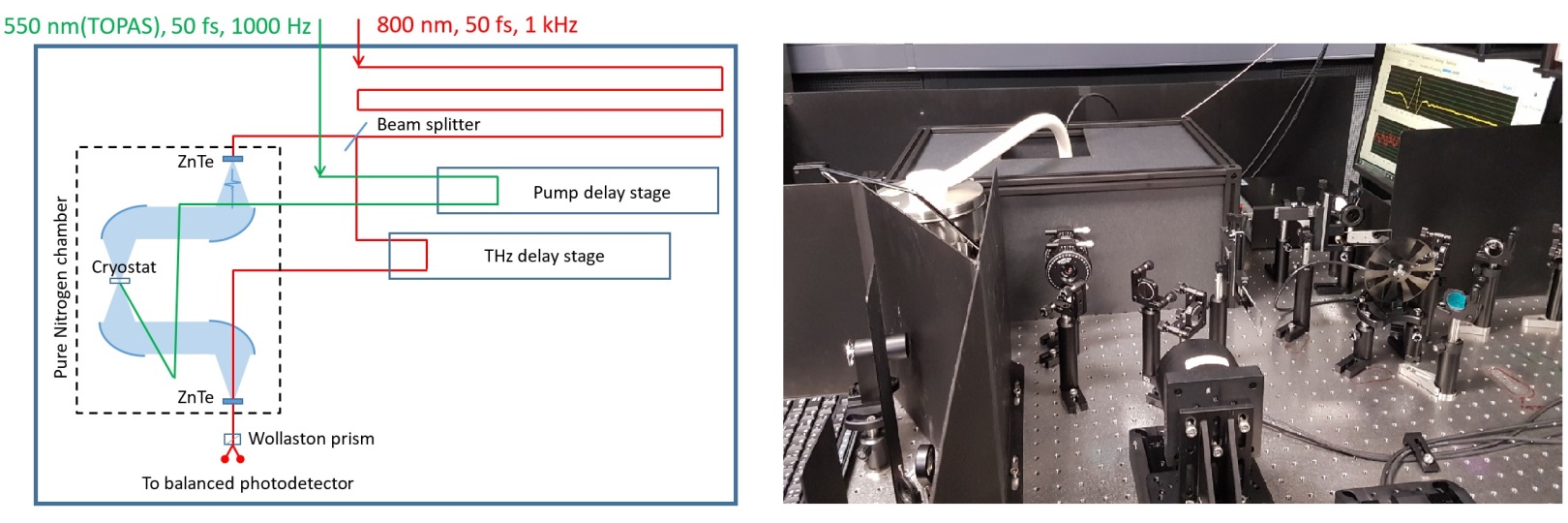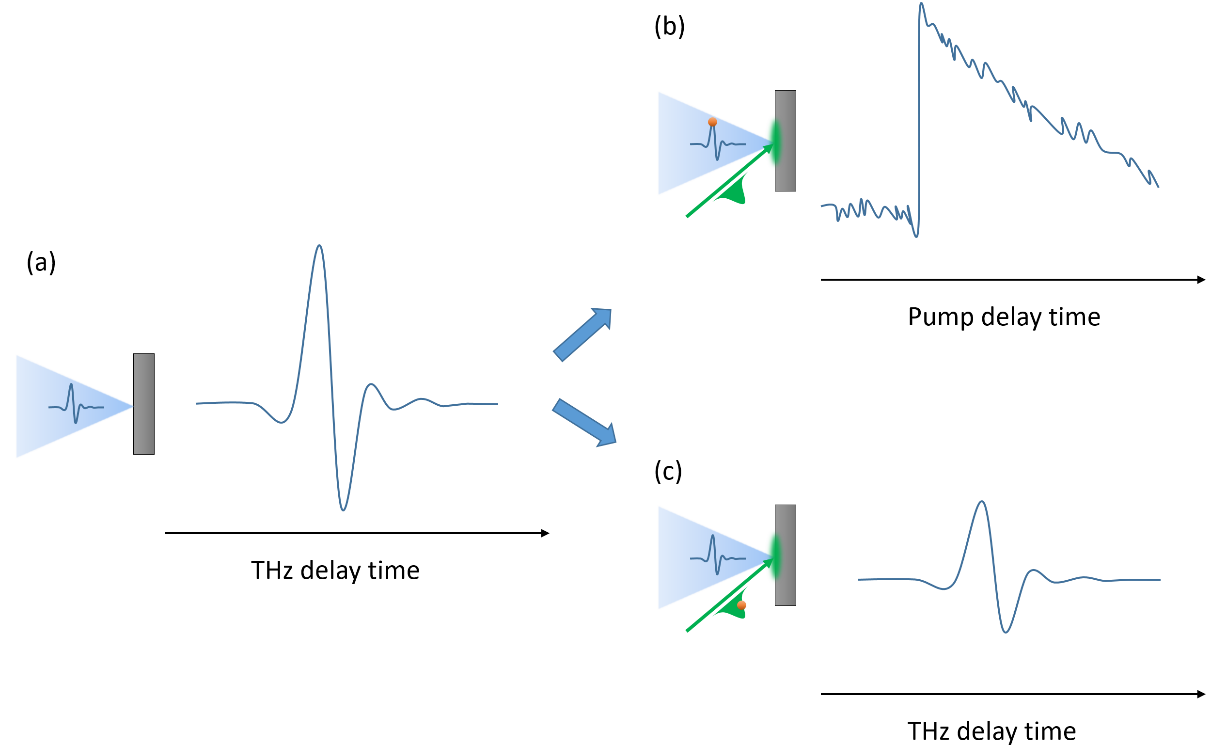
THz waves generally cover the electromagnetic spectrum between 0.1 and 10 THz, which is in between the infrared and microwave regions.
1 THz corresponds to 3000 μm wavelength and 4.1 meV photon energy. The energy of THz radiation is too low to cause ionization or thermal effects that can damage the material. Therefore, THz spectroscopy is suited for nondestructive, noninvasive inspection of materials and is considered safe for probing organic and biological samples. In addition, THz pump-probe time-domain spectroscopy, using sub-picosecond pulses in the THz frequency range (0.1 - 4 THz), is a very powerful all-optical spectroscopy technique. It can directly probe rotational transitions of molecules, vibrational modes in organic compounds, lattice vibrations in solids, and energy gaps in superconductors.
In our laboratory, we use two techniques of terahertz spectroscopy in order to probe ultrafast photo-initiated dynamics in active materials used in solar cells.
1-Terahertz time-domain spectroscopy:
Terahertz time-domain spectroscopy (THz TDS) is a technique based on Terahertz (THz) absorption spectroscopy. Our THz TDS setup uses a commercial Ti:sapphire amplifier operating at 800 nm with
a repetition rate of 1 kHz as laser source. The beam passes through a beam splitter, which splits it into two lines (Figure. 1 red lines), namely the pump and probe beam lines. The s-polarized pump beam is focused into a 1 mm thick <110> oriented
zinc telluride (ZnTe) crystal, the THz emitter. This generates THz radiation which is collected by gold-coated off-axis parabolic mirrors and passed through the sample. By changing the time delay between the pump and the probe beams by means of an
optical delay stage, electro-optic detection of THz transients is realized, when the THz pulse and the probe beams coincide in a co-propagating geometry inside the THz receiver crystal. The intensity difference of the vertical and horizontal
polarizations is detected by use of a λ/4 wave plate, a Wollaston prism, and a balanced photodetector. Lock-in techniques are used to measure the photodiode signal using the modulated bias field of the photo-conductive emitter as a reference.
All THz optics are enclosed in a chamber and purged continuously with dry nitrogen to prevent intensity losses of the THz beam due to absorption by water molecules in the air.

Figure.1 Schematic Ultrafast THZ Spectroscopy setups
2- Optical pump – terahertz probe spectroscopy:
Optical pump – terahertz probe spectroscopy (OPTP) (also called time-resolved terahertz spectroscopy) is a powerful tool to probe transient dynamics of photoexcited states in a wide
variety of materials, because it is sensitive to both the number of carriers and their distribution in energy.
The OPTP setup is conceptually very similar to the THz-TDS setup. However, it requires another pulsed laser beam which is used to excite
the sample. In our setup the pump pulse is generated from a TOPAS as shown in (Figure. 1 green line). In addition, to realize a transient measurement, a delay stage is used to vary the pump – THz probe delay time. Excited state dynamics
and charge carrier mobility are determined by measuring the change in transmission of terahertz probe pulses when passing through the sample at different delay times. A transient conductivity spectrum is acquired by scanning time delays between the
optical pump and the THz detection pulses synchronously at a fixed THz delay time (Figure. 2b). The photoconductivity can be calculated from the THz delay time at a fixed pump delay time (Figure. 2c).

Figure. 2 Schematic of two scanning methods in OPTP. (a) Typical THz TDS signal without pump. (b) Method 1: the THz delay time is fixed at the peak of (a), the pump pulse is focused to excite the sample, and the pump delay time is scanned. (c) Method 2: the pump is fixed at a specific delay time in (b) and the THz delay time is scanned.